Functional and anatomical reorganization of the sensory-motor cortex after incomplete spinal cord injury in adult rats
- PMID: 19793979
- PMCID: PMC6666156
- DOI: 10.1523/JNEUROSCI.1828-09.2009
Functional and anatomical reorganization of the sensory-motor cortex after incomplete spinal cord injury in adult rats
Abstract
A lateral hemisection injury of the cervical spinal cord results in Brown-Séquard syndrome in humans and rats. The hands/forelimbs on the injured side are rendered permanently impaired, but the legs/hindlimbs recover locomotor functions. This is accompanied by increased use of the forelimb on the uninjured side. Nothing is known about the cortical circuits that correspond to these behavioral adaptations. In this study, on adult rats with cervical spinal cord lateral hemisection lesions (at segment C3/4), we explored the sensory representation and corticospinal projection of the intact (ipsilesional) cortex. Using blood oxygenation level-dependent functional magnetic resonance imaging and voltage-sensitive dye (VSD) imaging, we found that the cortex develops an enhanced representation of the unimpaired forepaw by 12 weeks after injury. VSD imaging also revealed the cortical spatio-temporal dynamics in response to electrical stimulation of the ipsilateral forepaw or hindpaw. Interestingly, stimulation of the ipsilesional hindpaw at 12 weeks showed a distinct activation of the hindlimb area in the intact, ipsilateral cortex, probably via the injury-spared spinothalamic pathway. Anterograde tracing of corticospinal axons from the intact cortex showed sprouting to recross the midline, innervating the spinal segments below the injury in both cervical and lumbar segments. Retrograde tracing of these midline-crossing axons from the cervical spinal cord (at segment C6/7) revealed the formation of a new ipsilateral forelimb representation in the cortex. Our results demonstrate profound reorganizations of the intact sensory-motor cortex after unilateral spinal cord injury. These changes may contribute to the behavioral adaptations, notably for the recovery of the ipsilesional hindlimb.
Figures
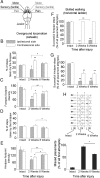
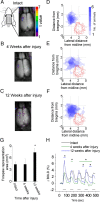
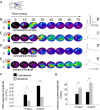

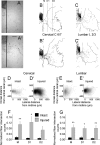
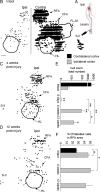
Similar articles
-
Ipsilesional Motor Cortex Plasticity Participates in Spontaneous Hindlimb Recovery after Lateral Hemisection of the Thoracic Spinal Cord in the Rat.J Neurosci. 2018 Nov 14;38(46):9977-9988. doi: 10.1523/JNEUROSCI.1062-18.2018. Epub 2018 Oct 9. J Neurosci. 2018. PMID: 30301755 Free PMC article.
-
Functional reorganization of the forepaw cortical representation immediately after thoracic spinal cord hemisection in rats.Exp Neurol. 2014 Jul;257:19-24. doi: 10.1016/j.expneurol.2014.03.015. Epub 2014 Mar 28. Exp Neurol. 2014. PMID: 24685666
-
Bridging the gap: a reticulo-propriospinal detour bypassing an incomplete spinal cord injury.J Neurosci. 2014 Oct 1;34(40):13399-410. doi: 10.1523/JNEUROSCI.0701-14.2014. J Neurosci. 2014. PMID: 25274818 Free PMC article.
-
Cortical and subcortical plasticity in the brains of humans, primates, and rats after damage to sensory afferents in the dorsal columns of the spinal cord.Exp Neurol. 2008 Feb;209(2):407-16. doi: 10.1016/j.expneurol.2007.06.014. Epub 2007 Jul 6. Exp Neurol. 2008. PMID: 17692844 Free PMC article. Review.
-
Descending bulbospinal pathways and recovery of respiratory motor function following spinal cord injury.Respir Physiol Neurobiol. 2009 Nov 30;169(2):115-22. doi: 10.1016/j.resp.2009.08.004. Epub 2009 Aug 12. Respir Physiol Neurobiol. 2009. PMID: 19682608 Review.
Cited by
-
The biological effect of contralateral forepaw stimulation in rat focal cerebral ischemia: a multispectral optical imaging study.Front Neuroenergetics. 2010 Jul 30;2:19. doi: 10.3389/fnene.2010.00019. eCollection 2010. Front Neuroenergetics. 2010. PMID: 20725601 Free PMC article.
-
Characterization of a graded cervical hemicontusion spinal cord injury model in adult male rats.J Neurotrauma. 2010 Nov;27(11):2091-106. doi: 10.1089/neu.2010.1424. J Neurotrauma. 2010. PMID: 21087156 Free PMC article.
-
Tracking sensory system atrophy and outcome prediction in spinal cord injury.Ann Neurol. 2015 Nov;78(5):751-61. doi: 10.1002/ana.24508. Epub 2015 Sep 18. Ann Neurol. 2015. PMID: 26290444 Free PMC article.
-
Association of pain and CNS structural changes after spinal cord injury.Sci Rep. 2016 Jan 6;6:18534. doi: 10.1038/srep18534. Sci Rep. 2016. PMID: 26732942 Free PMC article.
-
Assessments of sensory plasticity after spinal cord injury across species.Neurosci Lett. 2017 Jun 23;652:74-81. doi: 10.1016/j.neulet.2016.12.031. Epub 2016 Dec 19. Neurosci Lett. 2017. PMID: 28007646 Free PMC article. Review.
References
-
- Akintunde A, Buxton DF. Differential sites of origin and collateralization of corticospinal neurons in the rat: a multiple fluorescent retrograde tracer study. Brain Res. 1992;575:86–92. - PubMed
-
- Bolton DA, Tse AD, Ballermann M, Misiaszek JE, Fouad K. Task specific adaptations in rat locomotion: runway versus horizontal ladder. Behav Brain Res. 2006;168:272–279. - PubMed
-
- Brown-Séquard CE. Lectures on the physiology and pathology of the nervous system; and on the treatment of organic nervous affections. Lancet. 1868;92:593.
-
- Bruehlmeier M, Dietz V, Leenders KL, Roelcke U, Missimer J, Curt A. How does the human brain deal with a spinal cord injury? Eur J Neurosci. 1998;10:3918–3922. - PubMed
Publication types
MeSH terms
LinkOut - more resources
Full Text Sources
Medical
Miscellaneous
